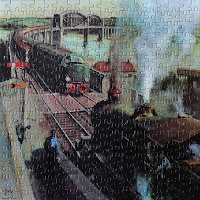As the title aptly describes, in today's post 28th September 2013, I am using a photograph of a jigsaw, in montage style, from Past Times. The puzzle is a 1000-piece example titled The Steam Train Revolution.
The images are superbly painted but the artist is not named, unfortunately (email me if you know who). Centrally placed is a portrait of Isambard Kingdom Brunel fronting his Royal Albert Bridge spanning the River Tamar between Devon and Cornwall. Locomotives included are as follows -
(1) An ex GWR 'Prairie' class 2-6-2 locomotive, No.4160, in early BR black livery. The 1948 locomotive was introduced onto GWR metals by Frederick Hawksworth but the 'Prairie' class locomotives were originally designed (3100 class) by George Jackson Churchward in 1903 and revised, later, by Charles Collett.
(2) A 'Large Bloomer' 2-2-2 locomotive of the London & North Western Railway designed by James McConnell. The locomotives were originally liveried in green, but in the 1870's this changed to the familiar 'Blackberry Black'. The legend describes this loco as an 'Extra Large Bloomer' - only three, with extra large 7ft 6" driving wheels, were built in 1861.
(3) The 'Coronation Scot' special train headed by a 'Princess Coronation' class 4-6-2 locomotive of (Sir) William Stanier. The LMS locomotive was built in 1937 one of five specially designed for the express service. All five were painted in 'Caledonian Blue' and white, with matching carriages; the colour was later change to red and gold.
(4) Although built by the GNR, a predecessor of the LNER, Flying Scotsman was the first locomotive to enter service with the LNER on 22nd February 1923 as an 'A1' class 4-6-2 locomotive, No.1472. She acquired her famous name and 4472 number in time for the 1924 British Empire Exhibition, and was the first locomotive to 'officially' break the 100mph barrier in November 1934. Flying Scotsman, designed by (Sir) Nigel Gresley was fitted with smoke deflectors ('blinkers') c1960.
(5) Another superb Gresley design was the 1938, 'A4' class 4-6-2 locomotive, No.4468 Mallard. More famous to some railway buffs than Flying Scotsman, Mallard still holds the world speed record for steam locomotion at nearly 126mph, set in July 1938.
(6) The Furness Railway 0-4-0 locomotive, No.20, is the oldest working, standard gauge locomotive in the world (built 1863) and is owned by the Furness Railway Trust. She is one of eight locomotives built by Sharp Stewart & Co. of Manchester, between 1863 and 1866. The FR livery is known as 'Indian Red'.
Also included with or among the locomotive illustrations are linemen working on the rails in a station; a packed luggage trolley; a signal box; a tunnel; a bridge; and two home signals on a double arm gantry.













.jpg)























.jpg)


